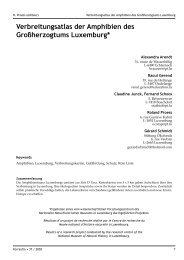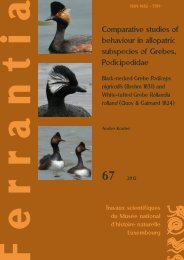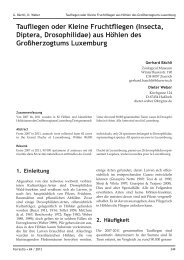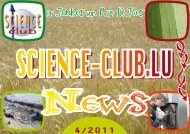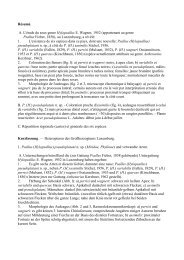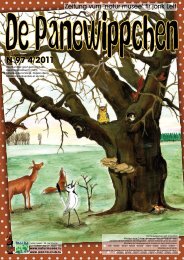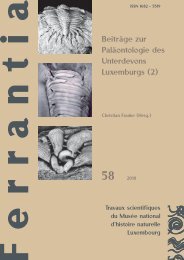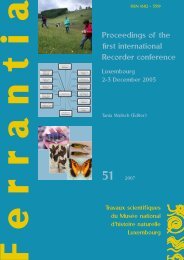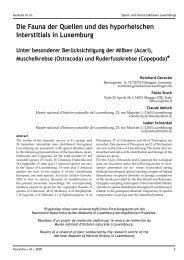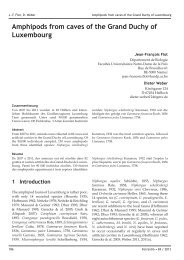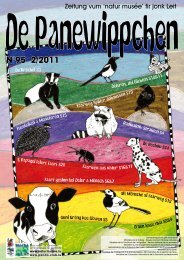Les bryophytes du Luxembourg - Musée national d'histoire naturelle
Les bryophytes du Luxembourg - Musée national d'histoire naturelle
Les bryophytes du Luxembourg - Musée national d'histoire naturelle
Create successful ePaper yourself
Turn your PDF publications into a flip-book with our unique Google optimized e-Paper software.
J. Werner <strong>Les</strong> <strong>bryophytes</strong> <strong>du</strong> <strong>Luxembourg</strong> - Liste annotée et atlas<br />
6<br />
<strong>Luxembourg</strong> has now 601 different taxa of <strong>bryophytes</strong><br />
(610, if border areas are included), comprising 140 liverworts<br />
and hornworts, which is about 87 % more than at<br />
the beginning of the XX th century. 27 infra-specific taxa are<br />
recognized. Comments are given on species restricted to<br />
foreign border areas. A classification according to families<br />
shows the overwhelming importance of Pottiaceae (81 taxa).<br />
The phytogeographic spectrum shows the predominance<br />
of temperate European elements, but also a strong (sub)<br />
oceanic and boreal influence; orophytes make up to 36 % of<br />
the bryophyte flora. The principal ecologies of <strong>bryophytes</strong><br />
are shortly described, showing the importance of epiliths,<br />
which are favored by a great variety of rocky substrates.<br />
Most <strong>bryophytes</strong> happen to be rather rare; merely one out of<br />
eight taxa is common all over the country. A short comment<br />
is given on species evidently regressing or progressing.<br />
Floristic richness (or biodiversity) is examined. A quantitative<br />
approach shows that a very small number of<br />
squares are rich; they are situated mostly in the Petite-<br />
Suisse area; southern Oesling and the Moselle valley are<br />
Zusammenfassung<br />
Luxemburg wird in zwei naturräumliche bzw. pflanzengeografische<br />
Landschaftseinheiten untergliedert<br />
(Oesling und Gutland), deren geologische, geografische<br />
und klimatische Eigenschaften kurz besprochen<br />
werden. Die Mooskartierung wurde auf Basis der 200<br />
Rasterquadrate des ehemaligen Institut Floristique<br />
Belgo-<strong>Luxembourg</strong>eois (4 x 4 km-Raster) <strong>du</strong>rchgeführt.<br />
Die ausländischen Anteile der grenzüberschneidenden<br />
Quadranten und Teilbereiche von 9 in Nordlothringen<br />
gelegenen Rastereinheiten wurden miteinbezogen. Eine<br />
umfangreiche Geländearbeit, zwischen den Jahren 1979<br />
und 2010, lieferte 22809 Datensätze.<br />
Aus Luxemburg sind nunmehr 601 verschiedene<br />
Moostaxa bekannt, darunter 137 Leber- und 3 Hornmoose.<br />
Das sind etwa 87 % mehr Arten als noch zu<br />
Anfang des XXten Jahrhunderts. 27 infraspezifische Taxa<br />
wurden mit aufgenommen. Arten, die ausschliesslich<br />
in o.g. Grenzregionen vorkommen, werden gesondert<br />
besprochen. Die Aufteilung nach Familien ergibt eine<br />
vergleichsweise hohe Zahl von Pottiaceen (81 Taxa).<br />
Die Analyse des Arealspektrums der Moosflora ergibt<br />
erwartungsgemäß ein Vorherrschen der temperaten,<br />
europäischen Florenelemente und erhebliche Anteile<br />
(sub)ozeanisch und nördlich verbreiteter Arten; die<br />
montanen Arten stellen 36 % des Gesamtinventars.<br />
Die wichtigsten Lebensräume der Moose werden kurz<br />
beschrieben. Hervorzuheben ist eine sehr artenreiche<br />
Felsmoosflora, die im Vorhandensein unterschiedlicher<br />
Gesteinsarten begründet ist. Die meisten Moosarten<br />
sind ziemlich selten. Nur eine von acht Moosarten ist<br />
also areas where richness is above average. The average<br />
number of <strong>bryophytes</strong> per IFBL-square is 114, the mean<br />
is 107. Bryophyte richness is also examined in an inter<strong>national</strong><br />
context. A more qualitative approach deals<br />
with the relation of the number of mosses to the number<br />
of liverworts (Lebermoosindex) and cites the richest<br />
and most complex natural sceneries. The bryological<br />
"hot spots" are also made out; they are based on three<br />
different criteria.<br />
The distribution of the bryophyte taxa is commented<br />
and a few evident distribution patterns are described.<br />
The reasons behind these patterns are shortly sketched,<br />
whether they are natural (climate, topography, geology)<br />
or artificial (cultivations, pollution).<br />
An annotated checklist gives information, for every<br />
recognized taxon, on the year of first publication, its<br />
frequency, its ecology, further papers (only for rare taxa)<br />
and the Red List status. Indivi<strong>du</strong>al numbered distribution<br />
maps are provided.<br />
Schlüsselwörter: Bryophyten – Anthocerotopsida – Hepaticopsida – Bryopsida – Atlas – Kartierung –<br />
Luxemburg – Kommentierte Checkliste – Nördliches Lothringen (Frankreich) – Ökologie – Biodiversität<br />
– Chorologie – Phytogeographie<br />
im ganzen Land häufig. Arten mit Ausbreitungstendenz<br />
oder Rückgang werden kurz kommentiert.<br />
Der floristische Reichtum (Biodiversität) wird sowohl<br />
quantitativ als auch qualitativ untersucht. Aus der rein<br />
quantitativen Analyse geht eine kleine Zahl von sehr<br />
artenreichen Rasterflächen hervor, welche größtenteils<br />
in der Kleinen Luxemburger Schweiz liegen; das<br />
südliche Oesling und das Moseltal sind zwei weitere<br />
Naturräume, in welchen der Artenreichtum über<strong>du</strong>rchschnittlich<br />
hoch ist. Der <strong>du</strong>rchschnittliche Artenreichtum<br />
der IFBL-Raster liegt bei 114, der Medianwert liegt bei<br />
107. Der Artenreichtum der Luxemburger Moosflora<br />
wird auch im inter<strong>national</strong>en Kontext betrachtet. Einige<br />
besonders artenreiche und komplexe Lebensräume<br />
werden vorgestellt. Die Bestimmung der hot spots erfolgt<br />
auf Basis von drei Kriterien.<br />
Die Verbreitung der Moose innerhalb Luxemburgs wird<br />
an Hand von einigen eindeutigen Verbreitungsmustern<br />
(distribution patterns) dargestellt und in Zusammenhang<br />
gestellt mit den naturräumlichen Gegebenheiten wie<br />
Klima, Topografie, Geologie, Boden bzw. anthropogenen<br />
Einflüssen wie Bodennutzung und Umweltverschmutzung.<br />
Eine Checklist mit Anmerkungen liefert für jedes Taxon<br />
Angaben zu Erstpublikation, Häufigkeit, Lebensraum,<br />
zusätzliche Literaturangaben (nur bei seltenen Arten)<br />
sowie den Rote-Liste-Status. Verbreitungskarten für die<br />
einzelnen Arten schliessen die Arbeit ab.<br />
Ferrantia • 65 / 2011



